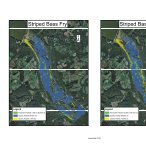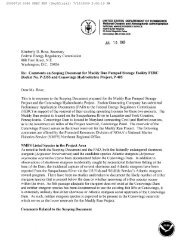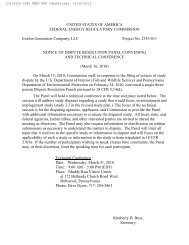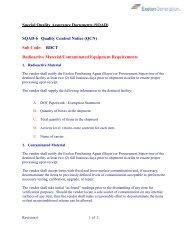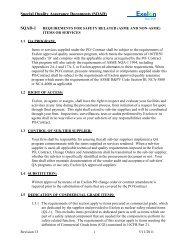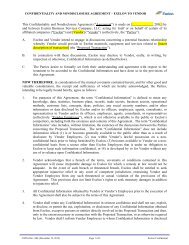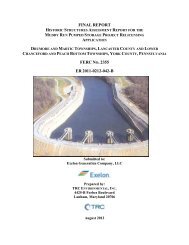FEDERAL ENERGY REGULATORY COMMISSION Project No. 405 ...
FEDERAL ENERGY REGULATORY COMMISSION Project No. 405 ...
FEDERAL ENERGY REGULATORY COMMISSION Project No. 405 ...
Create successful ePaper yourself
Turn your PDF publications into a flip-book with our unique Google optimized e-Paper software.
20100204-3055 FERC PDF (Unofficial) 02/04/2010<br />
<strong>Project</strong> <strong>No</strong>. <strong>405</strong>-087 2<br />
2) Lee’s Ferry – Extending the entire width of the river in the area known as<br />
‘Lee’s Ferry” and being generally perpendicular to the banks of the river in this<br />
area; and<br />
3) The Pool – Extending the entire width of the river in the area known as “The<br />
Pool” and being generally perpendicular to the banks of the river in this area.<br />
In addition, the agencies comment that in cases where there is an even number of<br />
points on a given transect upstream, the mid-point station could not be readily identified<br />
and suggest a method for identifying the mid-point station by depth measurement. For<br />
each transect, the mid-point station would be designated by measuring depth at the two<br />
transect points closest to the mid-point of the Conowingo Pond. The deeper of the two<br />
transect points would be designated as the mid-point station for that water quality<br />
transect.<br />
The agencies also comment that river flow data from the USGS gauge at<br />
Conowingo would provide additional useful data for the water quality study and<br />
recommend that river flow at the Conowingo USGS gauge be recorded for each water<br />
quality sampling event in addition to river flow at the Marietta USGS gauge.<br />
In water quality investigations performed at other hydropower facilities, studies<br />
that include water quality monitoring in the impoundment (upstream) typically include a<br />
downstream water quality monitoring component to evaluate the effects of the project on<br />
water quality. The additional water quality transects proposed by the agencies would<br />
provide useful information on impacts of the project downstream in the Lower<br />
Susquehanna River and the proposed methodology is consistent with generally accepted<br />
practice in the scientific community. Measuring water quality across a transect at station<br />
643 also would inform a decision about how representative station 643 is as a compliance<br />
point for water quality downstream of the project. With additional downstream water<br />
quality transects, recording river flow data downstream of the project at the Conowingo<br />
USGS gauge during each water quality sampling event would provide beneficial<br />
information to correlate water quality with river flow. In addition, the proposed<br />
designation of the mid-point station by depth measurement would ensure that the vertical<br />
profile water quality data captures a depth profile over each water quality transect.<br />
Therefore, staff believe it is reasonable to include the three water quality transects below<br />
the dam, recording river flow data for the Conowingo and Marietta USGS gauges<br />
whenever water quality is sampled, and a designation of the mid-point station to Task 1<br />
of the Water Quality Study. As such, Task 1 of the water quality study should be revised<br />
to include these modifications.<br />
Task 2 – Discharge boil water quality sampling





